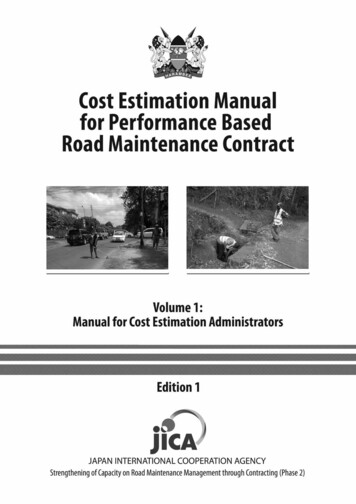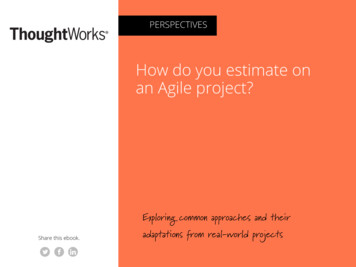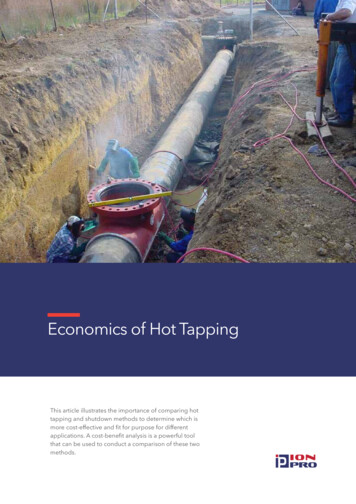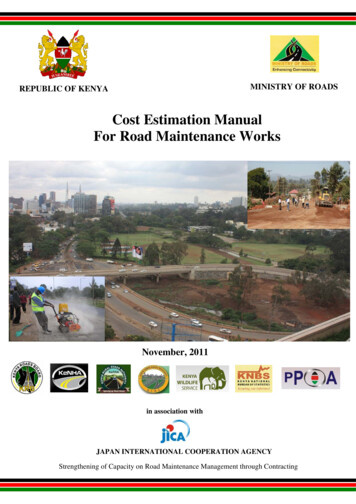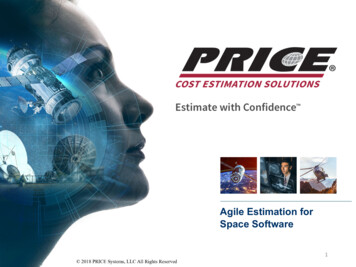
Transcription
Agile Estimation forSpace Software1 2018 PRICE Systems, LLC All Rights Reserved
Agenda IntroductionAgile Software DevelopmentAgile in SpaceSize and Cost Estimation for Agile SoftwareDevelopment Wrap UpEstimate With Confidence2
Introduction Agile development practices have enabled organizationsto deliver quality software that optimizes customersatisfaction But is agile for every type of projectSpace and other mission critical software have highreliability, fault tolerance requirements with strict safetyand performance criteriaOrganizations developing space based software arelooking for ways to do development faster, better andcheaperCan agile development practices facilitate thisrequirementEstimate With Confidence3
Introduction Back in the day Complexity of applicationswas overshadowed by the logistics ofimplementationTechnology improved today software solvesincreasingly complexity problemsThe so called ‘software crises’ (mid 60’s to 80’s)resulted in many ‘silver bullet’ type solutionsLots of smart software developmentprofessionals began looking for morelightweight methods to address complexity inachievable chunksEstimate With Confidence4
Agile SoftwareDevelopment
Agile Manifesto We are discovering better ways of developing software bydoing it and helping others do it Individuals and interactions over processes and tools Working software over comprehensive documentation Customer collaboration over contract negotiation Responding to change over following a plan All agile projects adhere to this manifest All agile projects share a common set of principles Each agile project uses a unique set of agile practices toimplement these principles Successful estimation for an agile project is like softwareestimation for any project – you need to understand theproject properties and the practices employedEstimate With Confidence6
Traditional Software Development Requirements are analyzedArchitecture and design are createdRequirements are implemented, tested and deliveredMonths (or longer) occur before there is usable softwarefor the customer to evaluateEstimate With Confidence7
Agile Software Development Usable chunks of software are developed in short periods of time (sprints, iterations, etc.) Requirements are translated into user stories and become the project backlog User stories deliver business value and are small enough to complete in an iteration Customer works with team and reviews software regularly Each iteration focuses on the user stories that are currently the highest priority of the customer Priorities may shift from iteration to iteration Agile teams expect and embrace changeEstimate With Confidence8
12 Guiding Principles for Agile DevelopmentEstimate With Confidence9
Common Agile Practices Pair programmingContinuous integration with automated testingTest driven developmentDaily stand up meetingsCo-located teamsCode refactoringSmall releasesCustomer on teamSimple designEstimate With Confidence10
Agile in Space
Agile in Space “NASA was agile before agile was a common term” Jim Highsmith – one of the 17 original authors of the manifesto – worked forNASA at one pointIn 1962 – John Paup was a senior NASA manager planningpart of the Apollo program First thing every morning all key people reported to his office for a stand upmeetingNASA Ames – Mission Control Technologies Adopted a hybrid agile solution – segregating activities constrained by mission criticalityfrom those more standard development activitiesCassini Mission 2015 (more than 10 years after the mission started) – the maintenance team hasadopted a hybrid agile process for software changesSoftware Probe Plus – built by JHU/APL Several of the ground system software module teams are adopting agile practicesEstimate With Confidence12
Challenges to Being Agile in Space Requirements for Compliance to industry standards andsponsor requirements CMMI AS9100 NASA Software Engineering Requirements (NPR 7150.2B) European Cooperation for Space Standardization (ECSS)Requirements for detailed documentationRequirements flexibility (or lack there of)Detailed up front planningRequirements for specialized capability (as opposed toagile teams composed of generalistsFormalized customer interfacesEstimate With Confidence13
But agile is a philosophy not a developmentprocess Hybrid applications make the most sense for space systems Agile practices that make sense Small teams evolving product in small visible steps Daily stand up meetings Pair programming Continuous automated testing Test driven development Collaborative planning (including the customer)Agile practices less likely to make sense Evolving requirements No formal up front planning Little to no documentation RefactoringEstimate With Confidence14
Agile CostEstimation
Agile estimation Frequently asked questions How to estimate size for an agile project when the team isworking with Story Points? What other cost drivers are indicated for an agiledevelopment project?Estimate With Confidence16
Agile Size Estimation Agile teams do a lot of their own estimation High level estimation as the backlog is created in the beginning of aproject (Sprint 0) Estimates are notional and only make sense to theteam Story points T-Shirt size Estimators challenge is to translate the teamsknowledge into a size measurement that relates totheir Cost Estimating Relationships (CERs) In the context of a parametric model – agile sizemeasures actually combine two typical cost drivers Size ComplexityEstimate With Confidence17
Fortunately agile teams collect lots of metricsEstimate With Confidence18
Agile Size Estimation Study of PRICE’s agile data found no correlation betweenstory points and software size or effortDid fine a significant relationship between software sizeand complexity (Functional Complexity in the PRICEmodel) pairs and effort.Estimate With Confidence19
Agile Cost Drivers The fact that your project is agile is not a costdriver There are potential cost implications toadopting agile practice Estimation team needs to determine whichagile practices applyEstimate With Confidence20
Agile Cost Drivers Agile teams tend to be highly skilled Hard to be a slacker in an agile environment Working closely with high skilled team members, learning curve fornew members is quick Input parameters to your model indicating team experience would beaffected Agile teams tend to have tool sets that arequite sophisticated This would be especially true on teams working with space systemsas it would greatly facilitate compliance to standards Input parameters around tools or automation would be affectedEstimate With Confidence21
Agile Cost Drivers Co-location of teams should improve team productivity Culture of interruption Questions answered in real time Team cohesion increases Co-locating stakeholders and SMEs with development team creates a real time IPT Well run stand-up meetings increase productivity and quality Cost drivers indicating distribution of team and communication practices would beaffectedEstimate With Confidence22
Agile Cost Drivers Continuous integration withautomated testing shouldincrease delivery productivity Important in space systems to maintain safetycritical compliance requirements. Code is checked in frequently and builds are runand test regularly before developers forget whatthey changed Red tests raise red flags – team fixes them rightaway Since little code is changed, errors are east totrack down Fixes occur quickly Cost drivers focused on integration testcomplexity would be affectedEstimate With Confidence23
Conclusion While not all agile practices make sense for spacesystems development, there are many that can (andhave) improved the ability to deliver high quality spacesystem software A hybrid version of agile is most appropriate for safetycritical software NASA has been successfully employing agile on manyprograms for many years Estimating an agile program is no different thatestimating any other software Understand the program and the process being employed Study data from previous similar programs Discuss project particulars with the delivery teamEstimate With Confidence24
Estimate With Confidence25
Agile Software Development Usable chunks of software are developed in short periods of time (sprints, iterations, etc.) Requirements are translated into user stories and become the project backlog User stories deliver business value and are small enough to complete in an iteration Customer works






